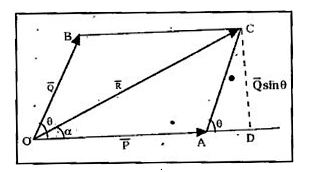State the parallelogram law of vectors and derive an expression for its magnitude
Parallelogram Law : If two vectors can be represented by the two adjacent sides of a parallelogram then the diagonal passing through the intersection of given vectors represents their resultant both in direction and magnitude
Proof : Let ¯¯¯Pand¯¯¯Q are two adjacent vectors with an angle .θ. between them . Construct a parallelogram OACB with OA =¯¯¯PandOB=¯¯¯Q as adjacent sides . Extend the line OA and drop an normal D from C . The diagonal OC gives the resultant ¯¯¯R both in direction and magnitude

in figure OCD is a right angle triangle
∴OC2=OD2+DC2
But OD=OA+AD=¯¯¯P+¯¯¯Qcosθ
and CD=¯¯¯QsinθandOC=¯¯¯R
∴¯¯¯R2=[¯¯¯R+¯¯¯Qcosθ]2+[¯¯¯Qsinθ]2
¯¯¯R2=¯¯¯P2+¯¯¯Q2cos2θ+2¯¯¯¯¯¯PQcosθ+¯¯¯Q2sin2θ
∴¯¯¯R∘=¯¯¯P2+¯¯¯Q2(sin2θ+cos2θ)+2¯¯¯¯¯¯PQcosθ
But sin2θ+cos2θ=1
∴¯¯¯R2=¯¯¯P2+¯¯¯Q2+2¯¯¯¯¯¯PQcosθ
Resultant vector ,¯¯¯R=√¯¯¯P2+¯¯¯Q2+2¯¯¯¯¯¯PQcosθ
Angle of resultant with adjacent side .α.
tanα=CDOD(∴OD=OA+AD)
Tan αCDOA+aD=¯¯¯Qsinθ¯¯¯P+¯¯¯Qcosθ ( ∴AD=¯¯¯Qcosθ)
Angle of ¯¯¯R with adjacent side, α=tan−1[¯¯¯Qsinθ¯¯¯P+¯¯¯Qcosθ]
Topper's Solved these Questions
- MODEL PAPER 11BOOK - VGS PUBLICATION-BRILLIANTCHAPTER - MODEL PAPER 11EXERCISE - Section - C
3 Videos
- MODEL PAPER 11BOOK - VGS PUBLICATION-BRILLIANTCHAPTER - MODEL PAPER 11EXERCISE - Section - C
3 Videos
- MODEL PAPER 10BOOK - VGS PUBLICATION-BRILLIANTCHAPTER - MODEL PAPER 10EXERCISE - Section - C
3 Videos
- MODEL PAPER 12BOOK - VGS PUBLICATION-BRILLIANTCHAPTER - MODEL PAPER 12EXERCISE - SECTION - C
3 Videos
Similar Questions
Knowledge Check
In parallelogram law of vector, the direction of resultant vector is given by
Atanα=QcosθP+QsinθBtanα=QsinθP+QcosθCtanα=PsinθP+QcosθDtanα=PcosθP+QcosθParallelogram law of vectors is applicable to the addition of :
AAny two vectorsBTwo scalarsCA vector and a scallarDTwo vectors representing same physical quantity.
State parallelogram law of vectors addition .Find analytcallly the magnitude and direction of resultant vector, When (i) two vectors are parallel to each other (ii) two vectors are perpendicular to each other.
View SolutionState parallelogram law of vector addition. Find analytically the magnitude and direction of resultant vector. Apply it to find the resultant when,
(i) Two vectors are parallel to each other
(ii) Two vectors are perpendicular to each other
View SolutionState parallelogram law of vector addition. Find analytically the magnitude and direction of resultant vector. Apply it to find the resultant when,
(i) Two vectors are parallel to each other
(ii) Two vectors are perpendicular to each other
View SolutionParallelogram law of addition of vectors
View Solution(a) Write law of parallelogram of vector and obtain the expression for the resultant of two vectors acting in two different directions.
View SolutionParallelogram law of vectors is applicable to the addition of :
View Solution
